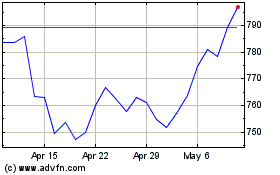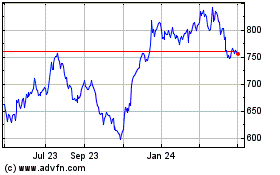By Randall Smith
Closed-end funds, the has-beens of the mutual-fund world, are
getting a chance for a second life.
The flood of investment dollars into low-cost index funds has
challenged many of Wall Street's most expensive offerings, few more
so than closed-end funds. In the decade after the financial crisis,
assets under management doubled in stock and bond mutual funds but
remained stagnant in closed-end funds, where the total in July
stood at $254.7 billion. Annual average new-issue volume,
meanwhile, fell from $13.2 billion in the decade ended in 2013 to
$2 billion for the next five years, according to Dealogic.
But now some big-name fund managers, led by TIAA's Nuveen and
BlackRock Inc., the top two closed-end sponsors, are making moves
to revive the sector, in part by revamping their structure. These
moves include having the fund sponsors, not investors, pay the
sales commissions that brokerage firms charge for selling the
funds. New closed-end funds also come with term limits that give
investors the option of getting out at par after a certain number
of years.
Closed-end funds generally offer higher yields than open-end,
often increased by borrowing, which also adds to risk. Those yields
can be tempting in today's low-rate environment. But average
investors shouldn't take the plunge without understanding the
higher fees and risks. The average expense ratio for these funds,
for example, is currently more than double the average for actively
managed open-end funds, according to Morningstar. And the risks
were on display in this year's market plunge, when several energy
funds were forced by their use of borrowing to sell assets or
liquidate.
What closed-ends are
While ordinary open-end funds expand or shrink based on
investors' purchases and sales, closed-end funds maintain a more
stable asset level because they issue shares as public companies.
Their shares may trade at a premium, or more often a discount, to
the value of their holdings.
Closed-end funds were in vogue in the 1980s, offering access to
star managers like John Templeton, Martin Zweig and Mario Gabelli.
In the 1990s a run of "country funds" featured stocks from Taiwan
or South Korea that weren't then widely available.
Since then, bond funds have come to dominate the closed-end
sector. Falling interest rates have served as a tailwind for
performance. Annual returns of closed-end bond funds topped those
of active open bond funds in the decade ended June 30. (Closed-end
stock funds trailed active open-end stock funds during the period.)
Reasons for the higher expenses include borrowing costs, management
fees based on the extra debt-financed assets, and costs of
acquiring illiquid or hard-to-find assets.
A 2018 study by Diana Shao and Jay Ritter at the University of
Florida found that closed-end funds underperformed other funds by a
wide margin in their first year of existence. Yet Prof. Ritter
believes such funds can be useful as sources of high-yield income,
if bought at discounts in small doses to limit risk.
Mike Holland, a Wall Street executive who helped launch a
closed-end China fund in 1992 and remains a director of a
high-yield utility closed-end fund, says, "There are pockets of
this market where if you are very careful and very lucky you can do
quite well." But their allure has faded as lower-cost options have
proliferated, he adds.
Dave Lamb, head of closed-end funds at Nuveen, says their
ability to deliver higher distributions by using leverage or
borrowing appeals to wealthier investors "approaching or in
retirement."
For example, the Nuveen AMT-Free Quality Municipal Income Fund
(NEA) has common stock valued at $4.4 billion, and borrows to boost
total assets by $2.5 billion. It had fees and expenses of 0.93% in
its latest full year, compared with 0.53% for a similar Nuveen
open-end fund. Its distributions were 4.4%, compared with 3.6% for
the open-end fund. But a drop in bond prices would hit the
closed-end fund harder.
Discounts and activists
The funds started struggling around 2014, as performance
weakened and the shares began trading at wider discounts of 10% or
more to net-asset value. A plunge in energy funds hit closed-end
stock funds' performance. That caused sales to slump and drew
vulture-like "activist" investors -- sharpening the need for action
by fund sponsors.
In response, the fund managers have tried to boost the funds'
appeal and narrow the discounts by paying the brokerage commissions
themselves, and by putting time limits on the funds' lifespan.
Thanks in part to pressure from the Investment Company
Institute, a fund-industry trade group, the closed-end sector also
has gotten help from the Securities and Exchange Commission against
attacks by activist investors. The SEC in May approved closed-end
funds' use of a Maryland law limiting the voting rights of
activists, thus potentially reducing the activists' ability to gain
control of funds or apply pressure for change.
Since 2019, new issues have rebounded, led by two BlackRock
stock funds, one for health science and the other for tech
companies. The two funds currently have $5.2 billon in assets
between them. Both funds have 12-year terms, and their expenses of
1.3% are one-third higher than BlackRock's comparable open-end
funds, in part because they aim to put some assets into
private-company stakes -- a more complicated task than simply
investing in publicly traded companies.
The activists' strategy, meanwhile, is typically to purchase
funds at discounted prices and then push for changes that could
narrow the discount and thus increase the market price of their
shares.
With a real or threatened proxy fight for control, they can push
a fund to liquidate or go open-end, both of which erase the
discount. Or they can push for a buyback of a percentage of the
fund's shares at a price close to par. Such scenarios often leave
the fund sponsors with fewer assets under management -- and fewer
fees.
Since 2015, activist investors led by Saba Capital Management LP
have engaged with managers of about 10% of all closed-end funds,
according to a Saba tally. They pushed 31 funds with a combined
market value of $6 billion to liquidate or go open-end. And they
persuaded 28 more to shrink by a total of 37% in dollar value via
buybacks.
Each fund's buyback reduces its number of shares outstanding,
without changing the per-share asset value. In buybacks, funds
offer a price close to full net asset value for a percentage of
their shares. The investors get cash for those shares, but the
funds' total assets shrink by the same percentage.
In the past year alone, Saba won a vote for board control of the
$701 million Voya Prime Rate Trust (PPR), according to AST Fund
Solutions LLC, a data, analytics, proxy advisory and solicitation
firm; Saba pressured two BlackRock muni funds valued at a combined
$107 million to go open-end; and it won buybacks near par of $605
million at three Legg Mason funds.
Saba founder Boaz Weinstein says his battles with fund managers
effectively "liberate thousands of investors from funds that charge
excessive fees," which cause the funds' persistent discounts.
After the SEC said it would allow funds in Maryland to limit
voting by holders of 10% stakes in closed-end funds, three fund
groups said 24 of their funds would "opt in" to the Maryland
limits. And BlackRock is moving five funds with $567 million in
combined value to Maryland via a series of mergers.
The risks of closed-ends' reliance on leverage was highlighted
earlier this year during the drop in energy-asset prices. Two
Goldman Sachs energy funds, sold for a combined $2.3 billion in
2013 and 2014, were abruptly forced to unwind an estimated $250
million of borrowings in March, liquidating some of their largest
holdings at distress prices. The result: life-of-fund losses of
95%.
And two Nuveen energy funds worth a total $698 million at their
offering prices in 2011 and 2014 had to be liquidated in May to
avoid bankruptcy, at asset values 93% below their IPOs. Prior
distributions offset more than one-quarter of the losses at the
Goldman funds and about half of the Nuveen funds' losses.
Mr. Smith, a former financial reporter for The Wall Street
Journal, is a writer in New York. He can be reached at
reports@wsj.com.
(END) Dow Jones Newswires
September 07, 2020 20:44 ET (00:44 GMT)
Copyright (c) 2020 Dow Jones & Company, Inc.
BlackRock (NYSE:BLK)
Historical Stock Chart
From Aug 2024 to Sep 2024

BlackRock (NYSE:BLK)
Historical Stock Chart
From Sep 2023 to Sep 2024
